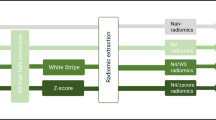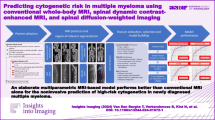Abstract
Objectives
Diagnostic accuracy of amino-acid PET for distinguishing progression from treatment-related changes (TRC) is currently based on single-center non-homogeneous glioma populations. Our study assesses the diagnostic value of static and dynamic [18F]FDOPA PET acquisitions to differentiate between high-grade glioma (HGG) recurrence and TRC in a large cohort sourced from two independent nuclear medicine centers.
Methods
We retrospectively identified 106 patients with suspected glioma recurrences (WHO GIII, n = 38; GIV, n = 68; IDH-mutant, n = 35, IDH-wildtype, n = 71). Patients underwent dynamic [18F]FDOPA PET/CT (n = 83) or PET/MRI (n = 23), and static tumor-to-background ratios (TBRs), metabolic tumor volumes and dynamic parameters (time to peak and slope) were determined. The final diagnosis was either defined by histopathology or a clinical-radiological follow-up at 6 months. Optimal [18F]FDOPA PET parameter cut-offs were obtained by receiver operating characteristic analysis. Predictive factors and clinical parameters were assessed using univariate and multivariate Cox regression survival analyses.
Results
Surgery or the clinical-radiological 6-month follow-up identified 71 progressions and 35 treatment-related changes. TBRmean, with a threshold of 1.8, best-differentiated glioma recurrence/progression from post-treatment changes in the whole population (sensitivity 82%, specificity 71%, p < 0.0001) whereas curve slope was only significantly different in IDH-mutant HGGs (n = 25). In survival analyses, MTV was a clinical independent predictor of progression-free and overall survival on the multivariate analysis (p ≤ 0.01). A curve slope > −0.12/h was an independent predictor for longer PFS in IDH-mutant HGGs
Conclusion
Our multicentric study confirms the high accuracy of [18F]FDOPA PET to differentiate recurrent malignant gliomas from TRC and emphasizes the diagnostic and prognostic value of dynamic acquisitions for IDH-mutant HGGs.
Key Points
• The diagnostic accuracy of dynamic amino-acid PET, for distinguishing progression from treatment-related changes, is currently based on single-center non-homogeneous glioma populations.
• This multicentric study confirms the high accuracy of static [ 18 F]FDOPA PET images for differentiating progression from treatment-related changes in a homogeneous population of high-grade gliomas and highlights the diagnostic and prognostic value of dynamic acquisitions for IDH-mutant high-grade gliomas.
• Dynamic acquisitions should be performed in IDH-mutant glioma patients to provide valuable information for the differential diagnosis of recurrence and treatment-related changes.




Similar content being viewed by others
Abbreviations
- ASL:
-
Arterial spin labelling
- DCE:
-
Dynamic contrast-enhanced
- FLAIR:
-
Fluid attenuation inversion recovery
- G:
-
Grade
- HGG:
-
High-grade glioma
- LGG:
-
Low-grade glioma
- MTV:
-
Metabolic tumor volume
- OS:
-
Overall survival
- PFS:
-
Progression-free survival
- RANO:
-
Response assessment in neuro-oncology
- rCBV:
-
Relative cerebral blood volumes
- ROC:
-
Receiver operating characteristic
- TAC:
-
Time-activity-curve
- TTP:
-
Time-to-peak
- WHO:
-
World health organization
References
Stupp R, Brada M, van den Bent MJ, Tonn J-C, Pentheroudakis G, ESMO Guidelines Working Group (2014) High-Grade Glioma: ESMO Clinical Practice Guidelines for diagnosis, treatment and follow-up. Ann Oncol 25(Suppl 3):iii93–ii101. https://doi.org/10.1093/annonc/mdu050
Louis DN, Perry A, Wesseling P et al (2021) The 2021 WHO classification of tumors of the central nervous system: a summary. Neuro Oncol. 23:1231–1251. https://doi.org/10.1093/neuonc/noab106
Marra JS, Mendes GP, Yoshinari GH, da Silva Guimarães F, Mazin SC, de Oliveira HF (2019) Survival after radiation therapy for high-grade glioma. Rep Pract Oncol Radiother 24:35–40. https://doi.org/10.1016/j.rpor.2018.09.003
Parvez K, Parvez A, Zadeh G (2014) The diagnosis and treatment of pseudoprogression, radiation necrosis and brain tumor recurrence. Int J Mol Sci 15:11832–11846. https://doi.org/10.3390/ijms150711832
Shah AH, Snelling B, Bregy A et al (2013) Discriminating radiation necrosis from tumor progression in gliomas: a systematic review what is the best imaging modality? J Neurooncol 112:141–152. https://doi.org/10.1007/s11060-013-1059-9
Law I, Albert NL, Arbizu J et al (2019) Joint EANM/EANO/RANO practice guidelines/SNMMI procedure standards for imaging of gliomas using PET with radiolabelled amino acids and [18F]FDG: version 1.0. Eur J Nucl Med Mol Imaging 46:540–557. https://doi.org/10.1007/s00259-018-4207-9
Albert NL, Weller M, Suchorska B et al (2016) Response assessment in Neuro-Oncology Working Group and European Association for neuro-oncology recommendations for the clinical use of PET imaging in gliomas. Neuro-Oncol. 18:1199–1208. https://doi.org/10.1093/neuonc/now058
Guedj E, Varrone A, Boellaard R et al (2022) EANM procedure guidelines for brain PET imaging using [18F]FDG, version 3. Eur J Nucl Med Mol Imaging 49:632–651. https://doi.org/10.1007/s00259-021-05603-w
Parent EE, Johnson DR, Gleason T, Villanueva-Meyer JE (2021) Neuro-Oncology Practice clinical debate: FDG PET to differentiate glioblastoma recurrence from treatment-related changes. Neurooncol Pract 8:518–525. https://doi.org/10.1093/nop/npab027
Karunanithi S, Sharma P, Kumar A et al (2013) 18F-FDOPA PET/CT for detection of recurrence in patients with glioma: prospective comparison with 18F-FDG PET/CT. Eur J Nucl Med Mol Imaging 40:1025–1035. https://doi.org/10.1007/s00259-013-2384-0
Tripathi M, Sharma R, D’Souza M et al (2009) Comparative evaluation of F-18 FDOPA, F-18 FDG, and F-18 FLT-PET/CT for metabolic imaging of low grade gliomas. Clin Nucl Med 34:878–883. https://doi.org/10.1097/RLU.0b013e3181becfe0
Li C, Yi C, Chen Y et al (2021) Identify Glioma recurrence and treatment effects with triple-tracer PET/CT. BMC Med Imaging 21:92. https://doi.org/10.1186/s12880-021-00624-1
Herrmann K, Czernin J, Cloughesy T et al (2014) Comparison of visual and semiquantitative analysis of 18F-FDOPA-PET/CT for recurrence detection in glioblastoma patients. Neuro Oncol. 16:603–609. https://doi.org/10.1093/neuonc/not166
Galldiks N, Stoffels G, Filss C et al (2015) The use of dynamic O-(2-18F-fluoroethyl)-L-tyrosine PET in the diagnosis of patients with progressive and recurrent glioma. Neuro Oncol. https://doi.org/10.1093/neuonc/nov088
Zaragori T, Ginet M, Marie P-Y et al (2020) Use of static and dynamic [18F]-F-DOPA PET parameters for detecting patients with glioma recurrence or progression. EJNMMI Res. 10. https://doi.org/10.1186/s13550-020-00645-x
Steidl E, Langen K-J, Hmeidan SA et al (2021) Sequential implementation of DSC-MR perfusion and dynamic [18F]FET PET allows efficient differentiation of glioma progression from treatment-related changes. Eur J Nucl Med Mol Imaging 48:1956–1965. https://doi.org/10.1007/s00259-020-05114-0
Bashir A, Mathilde Jacobsen S, Mølby Henriksen O et al (2019) Recurrent glioblastoma versus late posttreatment changes: diagnostic accuracy of O-(2-[18F]fluoroethyl)-L-tyrosine positron emission tomography (18F-FET PET). Neuro Oncol. 21:1595–1606. https://doi.org/10.1093/neuonc/noz166
Maurer GD, Brucker DP, Stoffels G et al (2020) 18 F-FET PET imaging in differentiating glioma progression from treatment-related changes: a single-center experience. J Nucl Med 61:505–511. https://doi.org/10.2967/jnumed.119.234757
Zaragori T, Oster J, Roch V et al (2021) 18 F-FDOPA PET for the non-invasive prediction of glioma molecular parameters: a radiomics study. J Nucl Med 63(1):147–157. https://doi.org/10.2967/jnumed.120.261545
Verger A, Imbert L, Zaragori T (2021) Dynamic amino-acid PET in neuro-oncology: a prognostic tool becomes essential. Eur J Nucl Med Mol Imaging. https://doi.org/10.1007/s00259-021-05530-w
Pyka T, Hiob D, Preibisch C et al (2018) Diagnosis of glioma recurrence using multiparametric dynamic 18F-fluoroethyl-tyrosine PET-MRI. Eur J Radiol 103:32–37. https://doi.org/10.1016/j.ejrad.2018.04.003
Mattoli MV, Trevisi G, Scolozzi V et al (2021) Dynamic 11C-methionine PET-CT: prognostic factors for disease progression and survival in patients with suspected glioma recurrence. Cancers 13:4777. https://doi.org/10.3390/cancers13194777
Wollenweber SD, Ambwani S, Delso G et al (2013) Evaluation of an atlas-based PET head attenuation correction using PET/CT & MR Patient Data. IEEE Trans Nucl Sci 60:3383–3390. https://doi.org/10.1109/TNS.2013.2273417
Nioche C, Orlhac F, Boughdad S et al (2018) LIFEx: a freeware for radiomic feature calculation in multimodality imaging to accelerate advances in the characterization of tumor heterogeneity. Cancer Res. 78:4786–4789. https://doi.org/10.1158/0008-5472.CAN-18-0125
Cicone F, Filss CP, Minniti G et al (2015) Volumetric assessment of recurrent or progressive gliomas: comparison between F-DOPA PET and perfusion-weighted MRI. Eur J Nucl Med Mol Imaging 42:905–915. https://doi.org/10.1007/s00259-015-3018-5
Orlhac F, Boughdad S, Philippe C et al (2018) A postreconstruction harmonization method for multicenter radiomic studies in PET. J Nucl Med 59:1321–1328. https://doi.org/10.2967/jnumed.117.199935
Wen PY, Chang SM, Van den Bent MJ, Vogelbaum MA, Macdonald DR, Lee EQ (2017) Response assessment in neuro-oncology clinical trials. J Clin Oncol 35:2439–2449. https://doi.org/10.1200/JCO.2017.72.7511
Stupp R, Mason WP, van den Bent MJ et al (2005) Radiotherapy plus concomitant and adjuvant temozolomide for glioblastoma. N Engl J Med 352:987–996. https://doi.org/10.1056/NEJMoa043330
Cui M, Zorrilla-Veloz RI, Hu J, Guan B, Ma X (2021) Diagnostic accuracy of PET for differentiating true glioma progression from post treatment-related changes: a systematic review and meta-Analysis. Front Neurol 12. https://doi.org/10.3389/fneur.2021.671867
Youland RS, Pafundi DH, Brinkmann DH et al (2018) Prospective trial evaluating the sensitivity and specificity of 3,4-dihydroxy-6-[18F]-fluoro-l-phenylalanine (18F-DOPA) PET and MRI in patients with recurrent gliomas. J Neurooncol 137:583–591. https://doi.org/10.1007/s11060-018-2750-7
Suchorska B, Jansen NL, Linn J et al (2015) Biological tumor volume in 18FET-PET before radiochemotherapy correlates with survival in GBM. Neurology 84:710–719. https://doi.org/10.1212/WNL.0000000000001262
Yoo MY, Paeng JC, Cheon GJ et al (2015) Prognostic value of metabolic tumor volume on 11C-methionine PET in Predicting progression-free survival in high-grade glioma. Nucl Med Mol Imaging 49:291–297. https://doi.org/10.1007/s13139-015-0362-0
Mittlmeier LM, Suchorska B, Ruf V et al (2021) 18F-FET PET uptake characteristics of long-term IDH-wildtype diffuse glioma survivors. Cancers 13:3163. https://doi.org/10.3390/cancers13133163
Kobayashi K, Hirata K, Yamaguchi S et al (2015) Prognostic value of volume-based measurements on 11C-methionine pet in glioma patients. Eur J Nucl Med Mol Imaging 42:1071–1080. https://doi.org/10.1007/s00259-015-3046-1
Compes P, Tabouret E, Etcheverry A et al (2019) Neuro-radiological characteristics of adult diffuse grade II and III Insular gliomas classified according to Who 2016. J Neurooncol 142:511–520. https://doi.org/10.1007/s11060-019-03122-1
Kickingereder P, Sahm F, Radbruch A et al (2015) IDH mutation status is associated with a distinct hypoxia/angiogenesis transcriptome signature which is non-invasively predictable with RCBV imaging in human glioma. Sci Rep 5. https://doi.org/10.1038/srep16238
Stadlbauer A, Zimmermann M, Kitzwögerer M et al (2017) MR imaging–derived oxygen metabolism and neovascularization characterization for grading and IDH gene mutation detection of gliomas. Radiology 283:799–809. https://doi.org/10.1148/radiol.2016161422
Clément A, Doyen M, Fauvelle F et al (2021) In Vivo characterization of physiological and metabolic changes related to isocitrate dehydrogenase 1 mutation expcression by multiparametric MRI and MRS in a rat model with orthotopically grafted human-derived glioblastoma cell lines. NMR Biomed. 34. https://doi.org/10.1002/nbm.4490
Pöpperl G, Kreth FW, Herms J et al (2006) Analysis of 18F-FET PET for Grading of recurrent gliomas: is evaluation of uptake kinetics superior to standard methods? J Nucl Med 47:393–403
Verger A, Filss CP, Lohmann P et al (2018) Comparison of O-(2- 18 F-Fluoroethyl)-L-tyrosine positron emission tomography and perfusion-weighted magnetic resonance imaging in the diagnosis of patients with progressive and recurrent glioma: a hybrid positron emission tomography/magnetic resonance study. World Neurosurg 113:e727–e737. https://doi.org/10.1016/j.wneu.2018.02.139
Funding
The authors state that this work has not received any funding.
Author information
Authors and Affiliations
Corresponding author
Ethics declarations
Guarantor
The scientific guarantor of this publication is Pr. Verger.
Conflict of interest
The authors of this manuscript declare no relationships with any companies whose products or services may be related to the subject matter of the article.
Statistics and biometry
One of the authors has significant statistical expertise (TZ).
Informed consent
Written informed consent was obtained from all subjects (patients) in this study.
Ethical approval
Institutional Review Board approval was obtained.
Methodology
• retrospective
• diagnostic or prognostic study
• multicenter study
Additional information
Publisher’s note
Springer Nature remains neutral with regard to jurisdictional claims in published maps and institutional affiliations.
Rights and permissions
Springer Nature or its licensor (e.g. a society or other partner) holds exclusive rights to this article under a publishing agreement with the author(s) or other rightsholder(s); author self-archiving of the accepted manuscript version of this article is solely governed by the terms of such publishing agreement and applicable law.
About this article
Cite this article
Rozenblum, L., Zaragori, T., Tran, S. et al. Differentiating high-grade glioma progression from treatment-related changes with dynamic [18F]FDOPA PET: a multicentric study. Eur Radiol 33, 2548–2560 (2023). https://doi.org/10.1007/s00330-022-09221-4
Received:
Revised:
Accepted:
Published:
Issue Date:
DOI: https://doi.org/10.1007/s00330-022-09221-4




